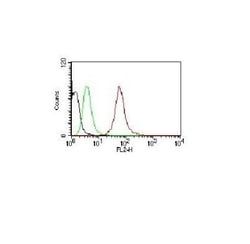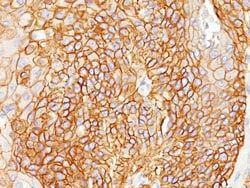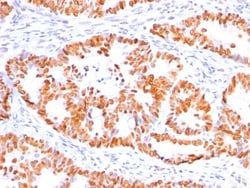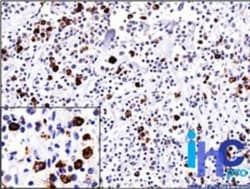p53 Antibody (BP53-12), Novus Biologicals™
Manufacturer: Novus Biologicals
Select a Size
| Pack Size | SKU | Availability | Price |
|---|---|---|---|
| Each of 1 | NBP229453-Each-of-1 | In Stock | ₹ 47,704.00 |
NBP229453 - Each of 1
In Stock
Quantity
1
Base Price: ₹ 47,704.00
GST (18%): ₹ 8,586.72
Total Price: ₹ 56,290.72
Antigen
p53
Classification
Monoclonal
Concentration
0.2 mg/ml
Dilution
Western Blot 0.5-1ug/ml, Simple Western 10 ug/ml, Flow Cytometry 0.5-1ug/million cells in 0.1ml, Immunocytochemistry/Immunofluorescence 1-2ug/ml, Immunoprecipitation 1-2ug/500ug protein lysate, Immunohistochemistry-Paraffin 0.5-1.0ug/ml, Immunohistochemistry-Frozen 0.5-1.0ug/ml
Gene Alias
Antigen NY-CO-13, FLJ92943, LFS1TRP53, p53, p53 tumor suppressor, P53cellular tumor antigen p53, Phosphoprotein p53, transformation-related protein 53, tumor protein p53, Tumor suppressor p53
Host Species
Mouse
Molecular Weight of Antigen
53 kDa
Quantity
0.1 mg
Research Discipline
Apoptosis, Cancer, Cell Cycle and Replication, Cellular Markers, Checkpoint signaling, Core ESC Like Genes, DNA Double Strand Break Repair, DNA Repair, HIF Target Genes, Hypoxia, Neuroscience, Neurotransmission, p53 Pathway, Phospho Specific, Stem Cell Markers, Transcription Factors and Regulators, Tumor Suppressors
Gene ID (Entrez)
7157
Target Species
Human, Mouse, Canine, Chicken, Hamster, Monkey, Mouse (Negative), Rat (Negative)
Form
Purified
Applications
Western Blot, Flow Cytometry, Immunocytochemistry, Immunofluorescence, Immunoprecipitation
Clone
BP53-12
Conjugate
Unconjugated
Gene Accession No.
P04637
Gene Symbols
TP53
Immunogen
Recombinant human wild-type p53 protein (Uniprot: P04637)
Purification Method
Protein A or G purified
Regulatory Status
RUO
Primary or Secondary
Primary
Test Specificity
This monoclonal antibody reacts with an N-terminal epitope (aa 16-25) of both wild type and mutated p53. Mutation and/or allelic loss of p53 is one of the causes of a variety of mesenchymal and epithelial tumors. If it occurs in the germ line, such tumors run in families. In most transformed and tumor cells the concentration of p53 is increased 51000 fold over the minute concentrations (1000 molecules cell) in normal cells, principally due to the increased half-life (4 h) compared to that of the wild-type (20 min). p53 Localizes in the nucleus, but is detectable at the plasma membrane during mitosis and when certain mutations modulate cytoplasmic/nuclear distribution. Mutations arise with an average frequency of 70% but incidence varies from zero in carcinoid lung tumors to 97% in primary melanomas. High concentrations of p53 protein are transiently expressed in human epidermis and superficial dermal fibroblasts following mild ultraviolet irradiation. Positive nuclear staining with p53
Content And Storage
Store at 4C.
Isotype
IgG2a κ
Related Products
Description
- Description p53 Monoclonal specifically detects p53 in Human, Canine, Chicken, Hamster, Monkey, Mouse (Negative), Rat (Negative) samples
- It is validated for Western Blot, Simple Western, Immunohistochemistry, Immunohistochemistry-Paraffin.










